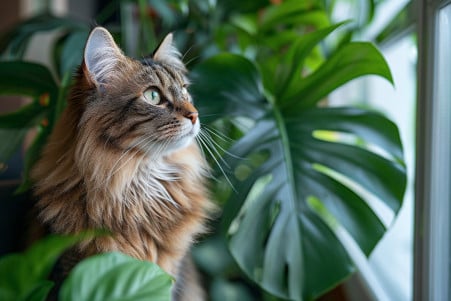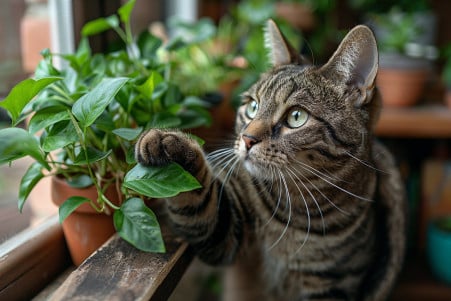Are Anthuriums Toxic to Cats? What Every Owner Needs to Know
8 May 2024 • Updated 7 May 2024

Anthuriums are beautiful, exotic flowers that are often kept as houseplants, but can they be dangerous to your inquisitive kitty? The answer is yes, anthuriums are toxic to cats. The leaves, stems, and flowers of anthurium plants all contain insoluble calcium oxalate crystals, which can lead to oral irritation, excessive drooling, vomiting, and difficulty swallowing if they are consumed by cats. Even if your cat only has a small amount of contact with the plant, it can lead to painful swelling in the mouth, lips, and tongue. Therefore, it's important to make sure that your cats can't access anthuriums.
In this article, we will review scientific studies and insights from experts to help you better understand exactly what compounds in anthuriums are toxic to cats. We will also look at case reports that describe what happens when cats accidentally eat anthuriums to get a better idea of the kind of symptoms that can occur and how they are typically treated. By the end of this article, you will have a thorough understanding of the reasons why this common houseplant can be dangerous to your feline friends and what you can do to protect them.
Are Anthuriums toxic to cats?
What Makes Anthuriums Toxic to Cats?
Anthuriums contain insoluble calcium oxalate crystals, which are the toxic principle that can harm cats, according to Pet Poison Helpline®. When a cat chews on or ingests part of the plant, these sharp crystals can penetrate and irritate the tissues of the mouth, throat, and gastrointestinal tract. As a result, cats that have eaten anthurium may exhibit signs of oral irritation, including drooling, pawing at the mouth, and decreased appetite, as explained in this expert response.
In some cases, swelling of the upper airway can occur, leading to breathing difficulties, according to Pet Poison Helpline®. The severity of a cat's reaction to eating an anthurium can vary from mild to life-threatening, and it depends on the amount of the plant that's been consumed, notes Plantly. However, even small amounts of the plant can cause a reaction in cats because insoluble calcium oxalate crystals are found throughout the anthurium.
First Aid and Veterinary Treatment of Anthurium Poisoning in Cats
If your cat has eaten an anthurium plant, immediate medical care is important to help alleviate the symptoms and prevent any further issues. According to Flamingo Flower Poisoning in Cats - Symptoms, Causes, Diagnosis, Treatment, Recovery, Management, Cost, first aid includes removing any remaining plant material from the cat's mouth and rinsing the mouth out with water if possible.
Veterinary treatment can include inducing vomiting, giving the cat activated charcoal to prevent the body from absorbing more toxins, and providing supportive care, according to Is Anthurium Toxic to Cats? Vet Approved Facts & FAQ - Catster. In more serious cases, the vet may give the cat medications to help with swelling and oxygen if the cat is having trouble breathing, according to Alert: Is Anthurium Toxic To Cats? Vital Safety Tips. Vets also recommend that cats are monitored and given a bland diet as they recover.
Non-Toxic and Pet-Safe Houseplant Alternatives to Anthuriums
For cat owners who don't want to risk their pet's health but still want to have some greenery in their home, there are many non-toxic houseplant options available, according to 26 Indoor Plants Safe for Cats and Dogs. Some non-toxic and pet-safe houseplants include Boston ferns, African violets, spider plants, certain succulents, and air plants.
However, when looking for new plants, it's important to check them against the ASPCA's list of toxic plants for cats and dogs, as pointed out by Lively Root. Some plants may be safe for one kind of pet but not the other, so it's important to look into the potential dangers of each plant, as explained in 20 Non-Toxic and Beautiful Houseplants That Are Safe for Cats.
In addition, offering safe alternatives like cat grass or keeping plants in places that cats can't get to can help prevent cats from eating plants, according to 22 Pet-Friendly Plants That Are Safe for Cats and Dogs and 20 Cat-Friendly House Plants.
How to Keep Cats Away From Poisonous Anthurium Plants
While it's important to keep anthuriums out of the reach of cats to avoid potential poisoning, according to Anthurium Is Toxic To Cats 🐈, there are several ways to make sure your cat isn't exposed to this toxic plant. For example, you can use physical barriers, such as high shelves and plant stands with wide bases, to keep cats away from the plants, as mentioned in Keeping Your Cat Out of Your Houseplants | Preventive Vet.
In addition, deterrents like citrus sprays and making the plants less attractive by covering the soil can help keep cats away from the plants, according to Anthurium Is Toxic To Cats 🐈. You can also redirect your cat's attention from toxic houseplants by providing safe alternatives like cat grass and interactive toys, as noted in Anthurium Watermaliense is Toxic to Cats 🐈.
If your cat does ingest an anthurium plant, it's important to remove any remaining plant material and get your cat to the vet immediately, as outlined in Anthurium Is Toxic To Cats 🐈. This will help ensure your cat gets the care they need to address their symptoms and avoid complications from the toxic calcium oxalate crystals found in all parts of the anthurium plant.
How Serious Is Anthurium Toxicity in Cats?
The severity of symptoms in cats that have ingested anthurium plants can depend on the amount of plant material that was eaten, according to Are Anthuriums Toxic to Cats? — Plant Girl Boss. Mild cases may cause localized mouth and throat irritation, drooling, and vomiting, while more severe cases can cause difficulty breathing or swallowing, according to Anthurium Is Toxic To Cats 🐈.
Veterinary care should be sought immediately because the toxic effects can escalate quickly and even result in neurological problems if not treated, according to Flora | Anthurium Toxicity: Safe or Harmful for Cats and Dogs?. Treatment will generally involve managing symptoms, inducing vomiting, administering activated charcoal, and providing supportive care, according to Are Anthuriums Toxic to Cats? — Plant Girl Boss.
Although anthurium toxicity is not likely to cause permanent damage, it can still be stressful and life-threatening for cats, according to Anthurium Is Toxic To Cats 🐈. It’s important to be watchful and act quickly to minimize the danger and ensure the well-being of your feline friends.
Conclusion: How to Protect Your Cat From Anthurium Plants
Anthurium plants are beautiful but dangerous for cats due to the calcium oxalate crystals they contain. If a cat eats any part of the plant, they can experience a variety of symptoms, from mild mouth and throat irritation to severe breathing problems that require immediate veterinary treatment.
To keep cats safe, it’s best to avoid having anthurium plants in the home or to make sure they are completely inaccessible to cats. Offering safe, non-toxic houseplants and providing cats with toys and cat grass can help keep them entertained and prevent them from investigating dangerous plants.
With a little knowledge and effort, cat owners can enjoy the benefits of indoor plants while keeping their pets safe.


